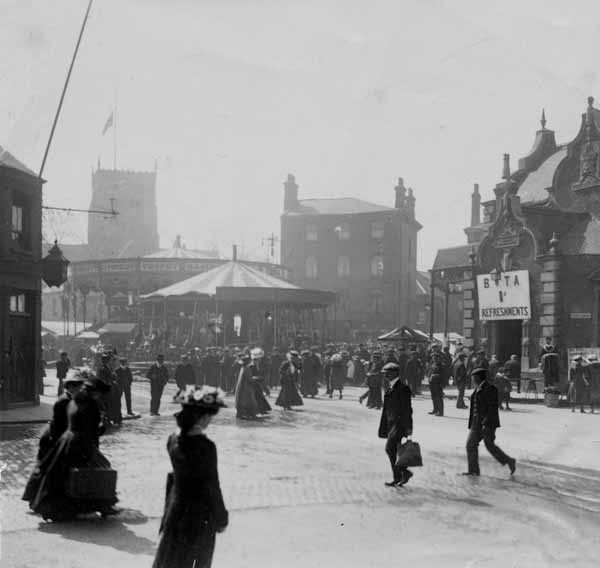Grimsby will fly its borough flag with pride over the Town Hall on Thursday 11 March 2021 marking the 820th anniversary of the issuing and sealing of its very first Royal Charter in 1201…but what did this significant event mean to the town?
Picture the scene. King John and his Royal entourage were in Clipstone, Nottinghamshire where, after a reported visit to Grimsby two months earlier, he officially witnessed the sealing of the borough’s first ever Royal Charter document.
Did you know?
- This 13th century Royal Charter paved the way for Grimsby to govern itself and set its own taxes – 14 years before the landmark Magna Carta document was signed, passing such control to other areas of the country. At that time Grimsby was one of only seven areas in England to have this responsibility.
- Responsibility for the town was handed to the “burgesses” – local people who became ‘Free Men’. Today the organisation called ‘The Enrolled Freemen of Grimsby’ is a registered charity with more than 1,000 men and women who are the direct descendants of those original burgesses, by birth, marriage, or apprenticeships, (apprenticeships in those times wereusually boys who signed up with a ‘master’ for around seven years, qualifying as ‘Journeymen’).
- Four days later, on 15 March 1201, King John granted a second charter allowing Grimsby to hold an annual 15-day fair from May 25.
- The Burgesses were also allowed to set up markets and today’s Freeman Street Market is owned by the Enrolled Freemen of Grimsby. Both that market and Grimsby’s Top Town Market, which is managed by ENGIE on behalf of North East Lincolnshire Council, are operated under the provisions of The Charter.
- The first ‘free’ grammar school was founded by the Freemen in 1547.
Sadly, Grimsby’s first charter was lost many years ago, but 14 other Royal Charters and Letters Patent remain in storage in Grimsby, and here are some of the highlights:
Charter of 1227: Issued by King John’s son, Henry III, and sealed at Westminster on June 20, 1227, it gave the men of the borough the right to account directly at the Exchequer for their own fee farm, which was the town’s annual payment to the Crown.
Charter of 1256 (Henry III): Sealed at Westminster on May 27, 1256, this document reduced Grimsby’s contribution to the Exchequer (fee farm rent) to £50. It also reserved to the King the advowsons of Grimsby and Scartho (an advowson is the right to nominate the vicar of the parish). This was followed in 1319 by Edward II’s Charter that confirmed and extended the provisions of 1256.
Exemplification of 1363 (Edward III): This ‘Letters Patent’ exemplifying the charter of 1319 was sealed on July 20, 1363. In an earlier Charter of 1329, Edward III had sanctioned the right to improve the navigation of the River Freshney and in the 1340s a dock was excavated, which was later known as the West Haven. Today this Garth Lane area is undergoing major improvements, under the management of ENGIE – the regeneration partner of North East Lincolnshire Council. This area is also part of Grimsby’s Heritage Action Zone, (HAZ). Meanwhile at the Town Hall, which also lies within the HAZ, a stone bust of King Edward III recognises the King’s contribution to promoting Grimsby’s maritime trade.
1391 & 1439: A further Charter was sealed by Richard II in 1391. That was followed by a Letters Patent that confirmed the provisions of an earlier patent and was sealed at Westminster on January 1, 1439, in the reign of Henry VI.
Royal letters issued by Henry VIII on March 4, 1510: The document covers the holding of judicial sessions in Grimsby and the types of offences that the court would be sanctioned to deal with.
June 29, 1510: One day after his 19th birthday, Henry VIII witnessed and sealed Royal Letters Patent, which confirmed the provisions of the charter of 1256 and the Letters Patent of 1439. There followed on November 7, 1510 a Royal pardon issued and sealed to the Mayor and Burgesses of Grimsby again by Henry VIII. A different King – this time Edward VI issued another Royal pardon in 1547 to the Mayor and Burgesses of Grimsby, which was sealed at Westminster on July 2, 1547. The Monarch was just nine at the time!
The Charter of Incorporation of 1688 by James II: This charter, sealed at Westminster on September 15, 1688, made the Mayor and Burgesses of Grimsby a corporate body, with a recorder, aldermen, coroners, common councilmen, bailiffs etc and conferred various privileges upon them. James was an unpopular monarch who was deposed only three months later.
Charter granting Grimsby borough status, 1974 (Elizabeth II): This brings us up to the time when Humberside County Council was created with Grimsby as a Borough Council.
Today, with the county council’s abolition in 1996, Grimsby is of course part of the North East Lincolnshire Council unitary authority. Fascinated by the town’s Charter history, Cllr Callum Procter, cabinet Cabinet member for Economic Growth, Housing and Tourism, said: “Our past will always shape our future and that is why heritage is so important. We are working hard to re-invigorate the town’s urban areas and that includes a variety of cultural and arts projects, which will offer reminders of that past.
“The anniversary of Grimsby’s first Charter is something we should be extremely proud of and I personally would like to see March 11 become an annual day on our town’s calendar in the future,” he added.
We thank the present Freemen, and Richard Bellamy in particular, for allowing the use of his research in this piece. For more information on the Enrolled Freemen of Grimsby please go to: http://www.enrolledfreemenofgrimsby.org/

Share this article